Digital Posters
Perfusion, Diffusion & Other Variables in Stroke Imaging
ISMRM & SMRT Annual Meeting • 15-20 May 2021

| Concurrent 6 | 17:00 - 18:00 |
4125.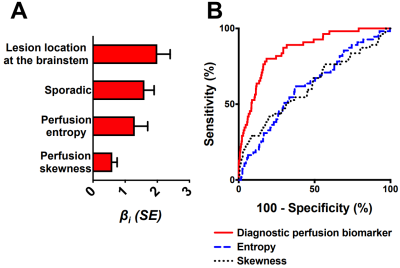 |
Perfusion And Permeability Imaging as Diagnostic And Prognostic Biomarkers of Cavernous Angioma with Symptomatic Hemorrhage
Je Yeong Sone1, Yan Li1,2, Nicholas Hobson1, Sharbel G. Romanos1, Abhinav Srinath1, Seán B. Lyne1, Abdallah Shkoukani1, Julián Carrión-Penagos1, Agnieszka Stadnik1, Kristina Piedad1, Rhonda Lightle1, Thomas Moore1, Ying Li1,
Dehua Bi1,3, Timothy Carroll4, Yuan Ji3, Romuald Girard1, and Issam A. Awad1
1Neurovascular Surgery Program, Section of Neurosurgery, Department of Surgery, University of Chicago Medicine and Biological Sciences, Chicago, IL, United States, 2Bioinformatics Core, Center for Research Informatics, The University of Chicago, Chicago, IL, United States, 3Department of Public Health Sciences, The University of Chicago, Chicago, IL, United States, 4Department of Diagnostic Radiology, University of Chicago Medicine and Biological Sciences, Chicago, IL, United States
A cavernous angioma with symptomatic hemorrhage (CASH) is more likely to rebleed for several years while conventional MRI signatures of hemorrhage may disappear after a few weeks. We aimed to investigate whether perfusion or permeability derivations of dynamic contrast-enhanced quantitative perfusion-MRI (DCEQP) can distinguish a lesion that had bled earlier or predict subsequent lesional bleeding/growth after DCEQP. Machine learning and Bayesian model selection showed that perfusion imaging may distinguish cases with CASH 3–12 months prior to the scan (diagnostic biomarker) while a combination of permeability and perfusion derivations may predict bleeding/growth in the subsequent year (prognostic biomarker).
|
|||
4126.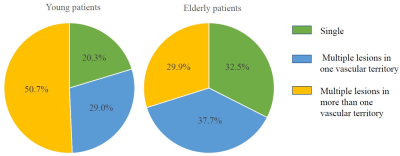 |
Differences in acute cerebral infarction distribution patterns between young and elderly patients: a MRI study
Dandan Yang1,2, Yongjun Han3, Dongye Li4, Huiyu Qiao2, Hualu Han2, Rui Shen2, Zihan Ning2, and Xihai Zhao2
1Capital Medical University, Beijing, China, 2Tsinghua University, Beijing, China, 3Aerospace Center Hospital, Beijing, China, 4Sun Yat-Sen Memorial Hospital, Guangzhou, China
This study aimed to determine the distribution patterns of acute cerebral infarction (ACI) between young and elderly patients with intracranial large artery stenosis using diffusion-weighted imaging. In total, 69 young patients and 77 elderly patients were included in this study. We found that young patients had significantly higher prevalence of multiple ACI lesions in more than one vascular territory and higher percentage of lesions in both anterior and posterior circulations than elderly patients. Our findings provide new insights in optimizing the etiological diagnosis of cerebrovascular disease for young and elderly patients.
|
|||
4127.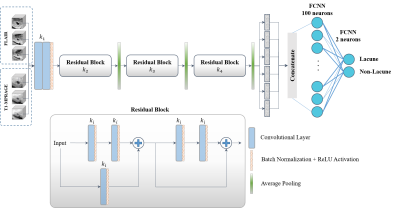 |
Computer-Aided Detection of Lacunes from FLAIR and T1-MPRAGE MR Images via 3D Multi-Scale Residual Networks
Mohammed A. Al-masni1, Woo-Ram Kim2, Eung Yeop Kim3, Young Noh4, and Dong-Hyun Kim1
1Department of Electrical and Electronic Engineering, College of Engineering, Yonsei University, Seoul, Korea, Republic of, 2Neuroscience Research Institute, Gachon University, Incheon, Korea, Republic of, 3Department of Radiology, Gachon University College of Medicine, Gachon University, Incheon, Korea, Republic of, 4Department of Neurology, Gachon University College of Medicine, Gachon University, Incheon, Korea, Republic of
Lacunes are small cerebrospinal fluid-filled lesions that are generated by the occlusion of penetrating deep branches of cerebral arteries. Early detection of lacunes could decrease the possible clinical implications such as dementia, gait impairment, and lacunar stroke. In this study, we propose a deep learning 3D multi-scale residual network for lacunes identification using FLAIR and T1-MPRAGE MR images. We redesign the proposed network via applying multiple parallel paths using different input scales. This enables to extract more robust contextual global features and hence achieve better detection performance. The proposed work exhibits its ability to distinguish true lacunes from non-lacunes.
|
|||
4128.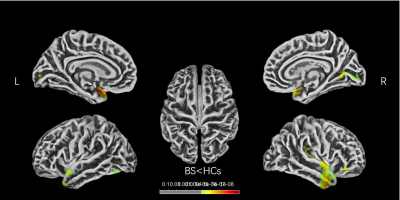 |
Abnormalities of Cortical Morphology and Structural Covariance Network in Patients With Subacute Basal Ganglia Stroke
Su Yan1, Guiling Zhang1, Weiyin Vivian Liu2, and Wenzhen Zhu1
1Radiology, Tongji Hospital, Tongji Medical College, Huazhong University of Science and Technology, Wuhan, China, 2MR Research, GE Healthcare, Beijing, China
The primary aim of this study was to examine the changes of cortical morphology in patients with unilateral basal ganglia stroke (BS) in subacute phase and evaluate the discrepancies of structural covariance networks (SCNs) between BS and HCs groups by using a seed-based structural covariance approach. The main findings were that BS could cause cortical atrophy of bilateral frontal and temporal lobes and abnormal structural covariance patterns, featured by decreased global efficiency and fragile topological properties in reaction to target attacks. These findings may enable us to better understand the neurobiological mechanisms of behavioral impairment and recovery after BS.
|
|||
4129.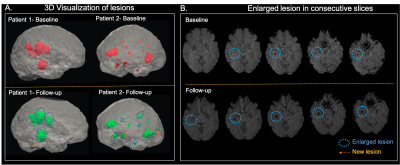 |
Relationship between MRI-derived lesion metrics and clinical characteristics in patients with Familial Cerebral Cavernous Malformations
Sivakami Avadiappan1, Jeffrey Nelson2, Marc Mabray3, Blaine Hart3, Leslie Morrison4, Atif Zafar4, Michel Torbey4, Helen Kim2,5, and Janine Lupo1
1Department of Radiology and Biomedical Imaging, University of California San Francisco, San Francisco, CA, United States, 2Department of Anesthesia and Perioperative Care, University of California San Francisco, San Francisco, CA, United States, 3Department of Radiology, University of New Mexico, Albuquerque, NM, United States, 4Department of Neurology, University of New Mexico, Albuquerque, NM, United States, 5Department of Epidemiology and Biostatistics, University of California San Francisco, San Francisco, CA, United States
Cerebral cavernous malformations (CCMs) are vascular lesions composed of abnormally enlarged small blood vessels and are characterized by symptoms such as seizures and hemorrhages. In this study, we explore the relationship between serial MR imaging metrics and clinical markers of CCM disease severity. A semi-automated algorithm was applied on 57 patients to segment lesions. Age was associated with lesion count and obesity was inversely related to the lesion count. The lesion burdens in brainstem and temporal lobe were related to hemorrhagic and seizure events. These imaging metrics can function as surrogate markers for risk stratification in these patients.
|
|||
4130.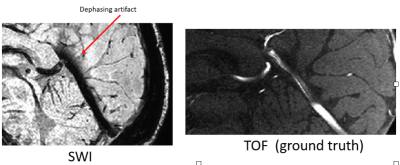 |
Comparing venous diameter from SWI with ground-truth venous diameter in straight sinus
Mehdi Zoghinia1, Mohammed Ayoub Alaoui Mhamdi1, and Russell Butler1,2
1Bishops university, sherbrooke, QC, Canada, 2Diagnostic Radiology, University of Sherbrooke, sherbrooke, QC, Canada
Paramagnetic deoxyhemoglobin introduces magnetic susceptibility to venous vessels in the brain, causing intra-voxel dephasing of surrounding tissue, appearing dark on a susceptibility-weighted image (SWI). However, empirical studies quantifying the extent of this dephasing is lacking. Using time-of-flight (TOF) angiogram as ground truth, and focusing on the straight sinus, we quantified the extent to which SWI vessel diameters deviated from true (TOF) vessel diameters. We find straight sinus diameter based on SWI segmentation to be nearly twice the diameter of TOF segmentation, and the difference between SWI and TOF straight sinus diameter was dependent on vessel location in the y-axis.
|
|||
4131.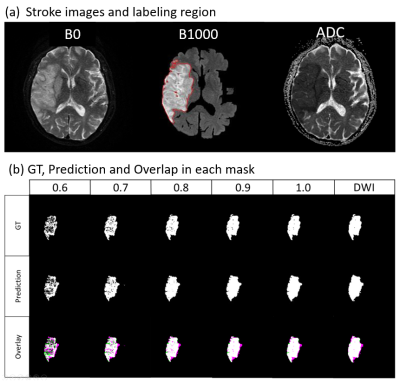 |
ADC and Size Dependent Segmentation Performance using Deep Learning
Chun-Jung Juan1, Yi-Jui Liu2, Shao-Chieh Lin3, and Yi-Hung Jeng4
1Department of Medical Imaging, China Medical University Hsinchu Hospital, Hsinchu, Taiwan, 2Department of Automatic Control Engineering, Feng Chia University, Taichung, Taiwan, 3Ph.D. program in Electrical and Communication Engineering, Feng Chia University, Taichung, Taiwan, 4Department of Biomedical Engineering and Environmental Sciences, National Tsing Hua University, Hsinchu, Taiwan, Hsinchu, Taiwan
Accurate automatic segmentation of acute ischemic infarction on diffusion-weighted images (DWI) is clinically important. However, the accuracy of automatic segmentation of stroke lesions is affected by a lot of factors. By applying graded ADC thresholds, our study verifies the value of ADC threshold on the performance of the deep learning models in segmenting acute ischemic infarction with increasing the Dice similarity coefficient (DSC) by the lowering the ADC threshold. In addition, our study provides a new window to distinguish cytotoxic edema and vasogenic edema in acute stroke. Moreover, our results further show a size-dependent influence of DSC for stroke segmentation.
|
|||
4132.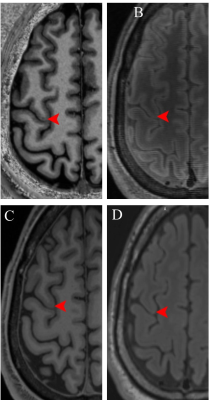 |
Cortical microinfarcts on 7T MRI correlate with medial temporal lobe thinning in healthy aging
Shokufeh Sadaghiani1, M. Dylan Tisdall2, Sandhitsu R. Das1, David A. Wolk1, and John A. Detre1
1Department of Neurology, University of Pennsylvania Perelman School of Medicine, Philadelphia, PA, United States, 2Department of Radiology, University of Pennsylvania Perelman School of Medicine, Philadelphia, PA, United States
We investigated the correlation of CMIs with MTL subregional cortical thickness in 21 healthy elderly subjects. We also showed that only 26% of total CMIs visible on 7T MRI scans are also visible on 3T scans suggesting a better visualization of CMIs by 7T MRI compared to 3T MRI. Our findings support an interaction between cerebrovascular and neurodegenerative mechanisms in healthy aging.
|
|||
4133.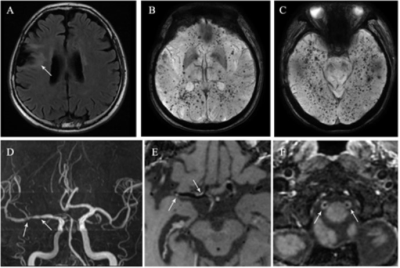 |
3D high resolution CUBE imaging in evaluating the imaging features of intracranial vasculopathy long after cranial irradiation
Huimin Mao1, Weiqiang Dou2, Xinyi Wang1, Xinyu Wang1, Kunjian Chen1, and Yu Guo1
1The First Affiliated Hospital of Shandong First Medical University, Jinan, China, 2GE Healthcare, MR Research China, Beijing, P.R. China, Beijing, China
The purpose of this study was to evaluate the imaging characteristics of intracranial large and small vessel diseases long after cranial irradiation. All patients with small vessel diseases underwent intracranial vessel wall imaging by 3D high resolution CUBE T1-weighted imaging (HR-MRI) to detect large vessel diseases. All recruited patients were found with intracranial small and large vessel diseases. Therefore, intracranial vasculopathy is not a rare complication after cranial irradiation, even in young patients. Patients after cranial irradiation should be followed up with MR imaging including HR-MRI.
|
|||
4134.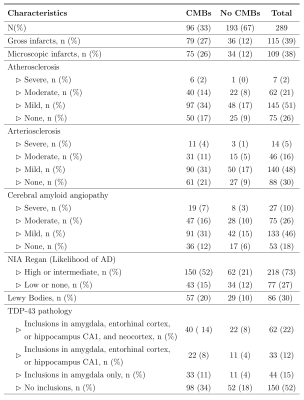 |
Neuropathologic correlates of cerebral microbleeds in community-based older adults
Grant Nikseresht1, Ashish A. Tamhane2, Nazanin Makkinejad3, Carles Javierre-Petit3, Gady Agam1, David A. Bennett2, Julie A. Schneider2, and Konstantinos Arfanakis2,3
1Department of Computer Science, Illinois Institute of Technology, Chicago, IL, United States, 2Rush Alzheimer's Disease Center, Rush University Medical Center, Chicago, IL, United States, 3Department of Biomedical Engineering, Illinois Institute of Technology, Chicago, IL, United States
Cerebral microbleeds (CMBs) are common in older adults and have been linked to hypertension, increased risk of stroke, and cognitive decline. There is also evidence of an association between CMBs and cerebral amyloid angiopathy (CAA) in studies involving clinical populations and patients with intracerebral hemorrhage. However, it remains unclear what the neuropathologic correlates of CMBs are in community-based older adults. The aim of this study was to determine the neuropathologic correlates of CMBs in community-based older adults, and also to investigate the relationship between neuropathologies and the location of CMBs in the brain.
|
|||
4135.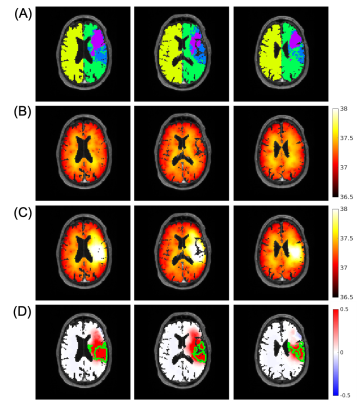 |
Personalized MR-derived brain temperature predictions after ischemic stroke – a case study
Dongsuk Sung1, Peter A. Kottke2, Jason W. Allen1,3,4, Benjamin B. Risk5, Fadi Nahab4, Andrei G. Fedorov2,6, and Candace C. Fleischer1,3,6
1Department of Biomedical Engineering, Georgia Institute of Technology and Emory University, Atlanta, GA, United States, 2Woodruff School of Mechanical Engineering, Georgia Institute of Technology, Atlanta, GA, United States, 3Department of Radiology and Imaging Sciences, Emory University School of Medicine, Atlanta, GA, United States, 4Department of Neurology, Emory University School of Medicine, Atlanta, GA, United States, 5Department of Biostatistics and Bioinformatics, Emory University, Atlanta, GA, United States, 6Petit Institute for Bioengineering and Bioscience, Georgia Institute of Technology, Atlanta, GA, United States
To prevent recurrent ischemic stroke, at-risk but viable tissue must be identified and reperfused. Conventional methods for identifying these regions can overestimate the infarct core leaving salvageable tissue untreated. To explore the use of brain temperature to identify viable tissue after stroke, we have refined our previous brain temperature model to simulate major cerebral artery occlusion and enable predictions of brain temperature evolution after stroke onset. Brain temperature was highest in ischemic penumbra followed by infarct core and lowest in healthy tissue, demonstrating its potential as an imaging biomarker for reperfusion therapy.
|
|||
4136.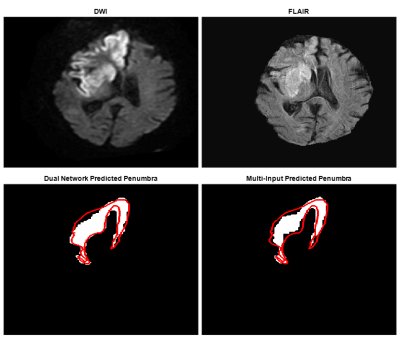 |
Automated Segmentation of Salvageable Ischemic Brain Tissue using Convolutional Neural Networks with DWI and FLAIR MRI
Ryan Andrew Rava1,2, Kenneth V. Snyder2,3, Muhammad Waqas2,3, Elad I. Levy2,3, Jason M. Davies2,3, Adnan H. Siddiqui2,3, and Ciprian N. Ionita1,2,3
1Biomedical Engineering, University at Buffalo, Buffalo, NY, United States, 2Canon Stroke and Vascular Research Center, Buffalo, NY, United States, 3Neurosurgery, University at Buffalo, Buffalo, NY, United States
Convolutional neural networks have the potential to predict penumbra volumes within acute ischemic stroke patients to determine their eligibility for mechanical thrombectomy based on the Defuse 3 clinical trial. Currently, computed tomography perfusion is the main method used to quantify penumbra volumes but not all stroke centers have this modality available. In this study, 2 networks were developed to automatically segment penumbra using FLAIR and DWI and performance metrics comparing each network’s predictions with ground truth penumbra (dual network: Dice=0.61, sensitivity=0.68, PPV=0.59, multi-input network: Dice=0.61, sensitivity=0.62, PPV=0.64) indicate a multi-input network is the most capable of segmenting penumbra tissue.
|
|||
4137.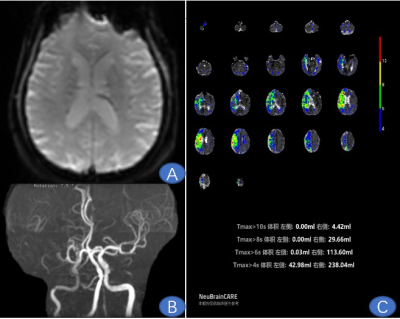 |
Integrating clinical and imaging features to predict recurrence of cerebrovascular events —— A machine learning study
mengting wei1, jinhao lv2, liuxian wang2, senhao zhang2, dongshan han2, xinrui wang2, and xin lou2
1Chinese PLA General Hospital, BeiJing, China, 2Chinese PLA General Hospital, beijing, China
Stroke is characterized by a high recurrence rate, and intervention after early identification of patients at risk of recurrence may improve their prognosis. After strict screening, 55 patients were enrolled in this study. the results show that it is feasible to identify patients with recurrent cerebrovascular events within one year by integrating clinical and imaging features through machine learning. RandomForest and NaiveBayes are the optimal algorithms, and HCR(hypoperfusion cubage ratio)can significantly optimize the recognition of these patients.
|
|||
4138.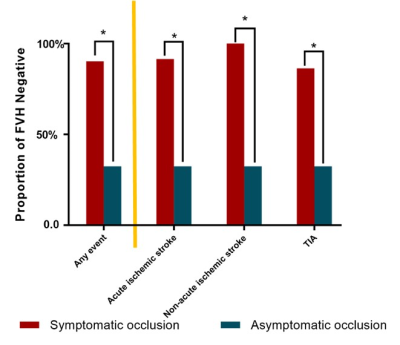 |
FLAIR Vascular Hyperintensity May Predict Ischemic Event in Patients with Internal Carotid Artery or Middle Cerebral Artery Occlusion
Jinhao Lyu1, Mengting Wei1, Xiangbing Bian1, Liuxian Wang1, Senhao Zhang1, Lin Ma1, and Xin Lou1
1Radiology, Chinese PLA General Hospital, The First Medical Center, Beijing, China
Intracranial artery steno-occlusive disease causes high morbidity of ischemic stroke occurrence and reoccurrence. The present study tested the presence of Fluid-Attenuated Inversion Recovery vascular hyperintensity (FVH) to discriminate symptomatic patients from asymptomatic patients in intracranial internal carotid artery or middle cerebral artery occlusion and found that the presence of FVH was independently associated with a recent ischemic event in these patients and negatively correlated with collateral circulation. The findings suggest that FVH may serve as a feasible imaging marker to identify high-risk cases in their follow-up and clinical management.
|
|||
4139.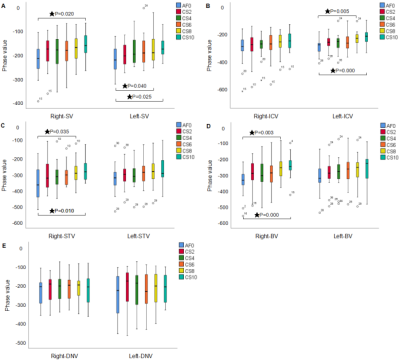 |
Optimized Acceleration Factor in Phase Measurement of Brain Deep Veins using SWI with Compressed Sensing
Jing Yang1, Yanwei Miao1, Yangyingqiu Liu 1, Yu Bing1, Bingbing Gao1, Jiazheng Wang2, Zhiwei Shen2, Ailian Liu1, Qingwei Song1, and Renwang Pu1
1First Affiliated Hospital of Dalian Medical University, Dalian, China, 2Philips Healthcare, Dalian, China
The MR scan time can be decreased using Compressed sensing with a favorable image quality. The study aimed to quantitative measure the oxygen concentration using Susceptibility Weighted Imaging (SWI) images with the different acceleration factors (AF), and explore the optimized AF of compressed sensing based on quantitative assessment of the image quality. Combined with the SNR and CNR, when the AF is 4, the scanning time can be reduced by 71.39%. For the phase value of deep veins, the AF can reach to 6 and the scan time is reduced to 1min8s without image quality change obviously.
|
|||
4140. |
Effect of Small Vessel Disease Burden on Collateral Perfusion in Symptomatic Large Vessel Stenosis or Occlusion
Liu-xian Wang1, Dong-shan Han1, Jin-hao Lyu1, and Xin Lou1
1the First Medical Center, Chinese PLA General Hospital, Beijing, China
Total SVD burden were not correlated with collateral perfusion, but perivascular space could impact collaterals.
|
|||
4141.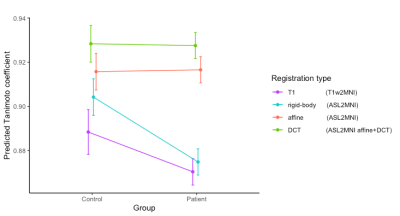 |
Using ASL perfusion images for spatial normalization in a pediatric population with craniosynostosis.
Catherine A. de Planque1, Henk J. Mutsaerts2, Vera C.W. Keil2, Nicole S. Erler1, Marjolein Dremmen1, Irene M.J. Mathijssen1, and Jan Peter3
1Erasmus University Medical Center, Rotterdam, Netherlands, 2Amsterdam UMC, Amsterdam, Netherlands, 3Institute of Radiopharmaceutical Cancer Research, Dresden, Germany
Spatial normalization is an important step for image processing and quantification of regional brain perfusion values using arterial spin labeling (ASL) MRI and is typically performed via high-resolution structural scans. Structural segmentation and/or registration is complicated when gray-white matter T1w contrast is low and changing in early phases of myelination in newborns. Craniosynostosis is a condition where the decision for surgical treatment in the first years of life is supported by brain imaging. In this study, we investigate if ASL CBF image contrast can be directly used for spatial normalization, in both healthy controls and a non-syndromic type of craniosynostosis.
|
|||
4142.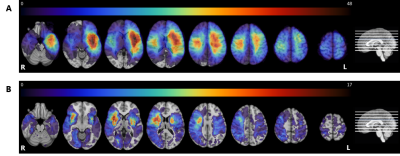 |
Can different etiologies provide converging evidence regarding the neural correlates of cognitive performance? Tumor versus stroke
Eva van Grinsven1, Anouk Smits1, Emma van Kessel1, Mathijs Raemaekers1, Edward de Haan2, Irene Huenges Wajer1,3, Veerle Ruijters1, Marielle Philippens4, Joost Verhoeff4, Pierre Robe1, Tom Snijders1, and Martine van Zandvoort1,3
1Department of Neurology & Neurosurgery, University Medical Center Utrecht Brain Center, Utrecht University, Utrecht, Netherlands, 2Department of Psychology, University of Amsterdam, Amsterdam, Netherlands, 3Department of Experimental Psychology and Helmholtz Institute, Utrecht University, Utrecht, Netherlands, 4Department of Radiotherapy, University Medical Center Utrecht, Utrecht, Netherlands
While lesion-symptom mapping can inform on which brain regions are crucial for a given behavior, it is still unclear whether different lesion etiologies show comparable structure-function relationships. In this study, support-vector regression lesion-symptom maps were compared between a glioma and stroke population. As expected, pathology distinct coverage patterns in the brain were found and there were more and larger significant voxel clusters in the tumor group. Our preliminary conclusion is that despite some differences in lesion-symptom associations in comparing a tumor and stroke population, these two populations can provide complementary information regarding involvement of brain regions for given cognitive tasks.
|
|||
4143.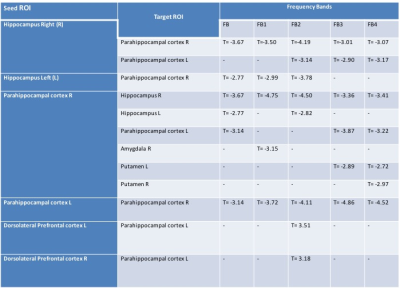 |
FREQUENCY DEPENDENT ALTERED FUNCTIONAL CONNECTIVITY OF DECLARATIVE MEMORY NETWORKS IN PATIENTS WITH DURAL ARTERIO-VENOUS FISTULA
Bejoy Thomas1, Josline Elsa Joseph1, Sabarish S Sekar1, Santhosh Kannath1, and Ramshekhar N Menon2
1Imaging Sciences and Interventional Radiology, Sree Chitra Tirunal Institute for Medical Sciences and Technology, Thiruvananthapuram, India, 2Neurology, Sree Chitra Tirunal Institute for Medical Sciences and Technology, Thiruvananthapuram, India
Dural Arteriovenous fistula (dAVF) causes cognitive deficits and associated memory impairment. The objective of this study was to understand the frequency dependent correlates of resting state functional connectivity of memory deficit presentations in dAVF. Our results reveal reduced functional connectivity, in a frequency dependent fashion, among hippocampus, parahippocampal cortex and dorsolateral prefrontal cortex, i.e.: regions involved in declarative memory functional processing.
|
|||
4144.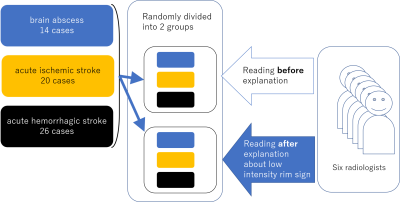 |
Usefulness of low intensity rim sign on DWI for differentiating brain abscess, acute ischemic stroke, and hemorrhagic stroke.
Takashi Abe1,2, Maki Otomo2, Rintaro Ito1, Rei Nakamichi1, Yumi Abe1, Toshiki Nakane1, Hisashi Kawai1, Toshiaki Taoka1, Shinji Naganawa1, and Masafumi Harada2
1Nagoya University, Nagoya, Japan, 2Tokushima University, Tokushima, Japan
Although it is often difficult to differentiate brain abscess, acute ischemic stroke, and hemorrhagic stroke on diffusion weighted image (DWI), the diagnosis can be made more accurately by focusing on the low signal intensity, especially the low intensity rim surrounding the lesion. In this study, image interpretation of six diagnostic radiologists (12.8 years of experience on average) showed an accuracy of 70% before explanation of the low intensity rim finding, but the accuracy increased to 86% after explanation (p = 0.025), confirming the importance of focusing on low intensity rim on DWI.
|
The International Society for Magnetic Resonance in Medicine is accredited by the Accreditation Council for Continuing Medical Education to provide continuing medical education for physicians.